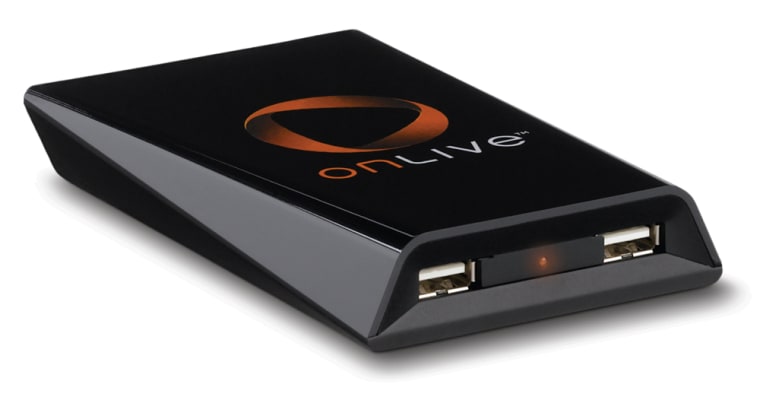Will OnLive change gaming as we know it? Or will it go the way of other promised on-demand game services — into the ether?
OnLive, a new streaming game system announced at last week’s Game Developer Conference, was arguably the biggest news of the show. Built by Steve Perlman, the guy who created WebTV (and sold it for a cool $500 million to Microsoft), OnLive promises to stream games live, over the Internet, with no lag.
Let me say that again: No lag. That’s a bold claim. If you’ve ever done a video conference at work or a Skype call, you know what lag looks like.
But Perlman, who also was involved with creating QuickTime for Apple way-back-when, knows data compression. And he says he and his 100-person team have, through seven years of trial and error, perfected a system that streams first-run, top-tier games to any entry-level PC, Mac or TV. All you need is broadband, and, if you go the TV route, a slender little MicroConsole.
The holy grail of gaming?
If true, OnLive could be the holy grail of gaming. It lets publishers give the finger to GameStop and other retailers, and distribute their games directly to consumers. It would eliminate piracy. And it makes the console war a moot point.
Perlman says he was initially inspired to create OnLive for this very reason. The successive generations of consoles are becoming way too pricey for consumers — evidenced, he says, by the $400 PlayStation 3’s struggle to gain widespread traction.
“If you can’t achieve the next-generation game systems by building hardware for the home, because it’s just way too expensive … where are you going to build it? It has to be in the cloud,” he says.
It's in the cloud
Cloud computing is a concept that’s gained widespread interest thanks to Google Apps and other Web-based software. It means, in essence, that you can use applications and software over the Internet, without pesky discs or downloads. OnLive extends this concept to games.
This isn’t the first time that a company has tried to free gamers from the shackles of — hardware and software. The long-promised “Phantom” on-demand game service was just that an apparition. Trion World Networks — whose name evokes images of some fictional “Austin Powers”-esque conglomerate — has raised $100 million for its server-based, real-time games. But OnLive, which goes into public beta this summer with a targeted end-of-year launch date, could be the first product to market.
Network log jams made worse?
OK, but wait a second here. If OnLive shifts the burden to the Internet, won’t that make network log jams even worse? Service providers like Comcast are already screaming bloody murder about high network usage — some ISPs are even charging customers that go over data-transfer limits.
But Perlman says that unlike peer-to-peer systems, which swamp ISPs limited traffic, “OnLive is only high-bandwidth downstream, with only a trickle upstream.”
Still, naysayers — and they are vocal — pooh-pooh this crazy notion of lag-free, on-demand gaming. They point out that today’s online games are only sending player data across the transom — and those games experience hiccups all the time.
'Not your father's servers'
Ah, but OnLive’s different, says Perlman. The system takes input from your controller (or keyboard) and connects the player to the OnLive service. Then, lickety-split, the service’s custom game servers — “these aren’t your father’s servers,” he jokes — render your game graphics. A super-secret video-encoding technology shoots back low-latency video, running Barry Sanders-like patterns through whatever routers and firewalls you’ve got going, and — bam. It’s like playing off a disc, says Perlman.
Still, he’s not expecting gamers to abandon their consoles en masse. “People have made a huge investment in those things and we expect them to play out that investment for a long time.” Initially, he says, OnLive will be, as he puts it, “additive.”
Michael Pachter, an analyst with Wedbush Morgan, agrees that OnLive isn’t going to steal away massive market share anytime soon.
“I don’t think these guys are getting 20 percent of the market tomorrow, I think they’re getting half a percent of the market within a year-and-a-half of launch,” he says. “And I think that’s meaningful enough to signal to us, directionally, that digital distribution is here.”
No announcement on price
As for the cost of the system, that hasn’t been announced. Perlman says that the subscription fees will be comparable to what Microsoft’s charging for Xbox Live ($50 per year), and the MicroConsole will either be sold at a price “vastly less expensive than the ($250) Wii,” or given away with a long-enough subscription.
Despite this being a potentially money-saving proposition for gamers, not all are welcoming the OnLive announcement with open arms. Nick Breckon, of the enthusiast site ShackNews, wrote that he saw “blocky pixels” playing “BioShock” over OnLive, and proclaimed it “unquestionably inferior to playing from a disc.” Those who commented on blog postings ranged from cautiously optimistic to nastily disdainful.
The publishers are excited, though — Electronic Arts, Ubisoft, Take Two Interactive and Warner Brothers among them — are jumping on board with OnLive. The only notable holdout is Activision Blizzard, publishers of “World of Warcraft” and “Call of Duty,” two extremely popular multiplayer games. And, of course, OnLive isn’t going to get a crack at console-exclusives such as “Halo” or “Metal Gear.”
But Pachter believes the target market — at least today — is not the hard-core player with a console. They see OnLive as just another platform, with games they’ve already got.
“We in the industry think the world revolves around the hard-core (player), but for this product, it’s about the next generation of hard-core players, who can’t afford it yet,” he says.
